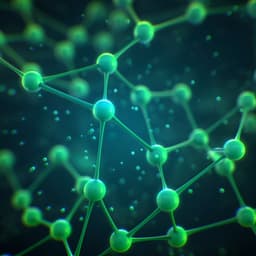
Chemistry
Taking a snapshot of the triplet excited state of an OLED organometallic luminophore using X-rays
G. Smolentsev, C. J. Milne, et al.
Unlocking the future of OLED technology, researchers delve into an innovative organometallic Cu complex to explore charge transfer mechanisms. Their groundbreaking findings offer essential insights into the structural dynamics of luminophores, paving the way for more accessible and efficient display technologies. This cutting-edge research was conducted by a team of experts, including Grigory Smolentsev, Christopher J. Milne, and others.
~3 min • Beginner • English
Introduction
The study addresses how charge transfer and structural rearrangements proceed in the lowest triplet excited state of a multicore organometallic copper luminophore relevant for OLEDs, with the goal of experimentally verifying where the excited-state charge originates and how the metal cluster structure responds. OLED efficiency can reach 100% by harvesting triplet excitons either via phosphorescence (PHOLEDs) or via thermally activated delayed fluorescence (TADF). Copper-based TADF luminophores are attractive due to earth-abundance and low cost, but minimizing non-radiative decay requires small structural reorganization between ground and excited states. While mononuclear Cu complexes are relatively well understood, the mechanisms in multicore organo-copper clusters remain unclear. The paper focuses on three key questions: which Cu sites (C- versus P-coordinated) participate in charge transfer; whether P atoms in the ligands are electronically involved; and how Cu–Cu distances change upon excitation. The authors use element-specific, time-resolved X-ray spectroscopies and solution scattering to resolve these aspects, thereby informing design principles for efficient, rigid Cu-based TADF emitters.
Literature Review
Prior work established that classical organic emitters are limited to 25% internal quantum efficiency, while heavy-metal PHOLEDs (Ir, Pt, Ru) can harvest triplets up to 100% but at high cost. Copper-based TADF materials have emerged with very high photoluminescence quantum yields (>99%), leveraging small singlet–triplet exchange energies that allow reverse intersystem crossing and delayed fluorescence. Efficient TADF performance depends on the singlet–triplet gap and suppression of non-radiative decay, particularly intramolecular vibrational quenching that increases with structural displacement between electronic states. For mononuclear Cu complexes, metal-to-ligand charge transfer with minimal structural rearrangement is desired and supported by theory and experiments. However, for multinuclear, organometallic Cu clusters, experimental insight is sparse and computational predictions vary widely, necessitating direct experimental probes. Time-resolved X-ray absorption/emission and scattering techniques at synchrotrons and XFELs have matured to provide element-specific electronic and structural information on nanosecond-to-microsecond timescales, motivating their application to this problem.
Methodology
System: The cationic tetranuclear organo-copper cluster [Cu4(PCP)3]+ (PCP = 2,6-(Ph2P)2CH3; counterion BArF4) with a rigid, core–shell-like structure containing two C-coordinated quasi-linear Cu sites and two P-coordinated trigonal-planar Cu sites. It exhibits bright green emission and long delayed photoluminescence lifetime in solid state.
Time-resolved Cu K-edge X-ray absorption spectroscopy (XANES): Conducted at the SuperXAS beamline (SLS). Pump–sequential–probes setup with asynchronous time-tagged photon counting and 30 ns time resolution. X-rays: Si(111) monochromator; focused to ~100×100 µm2; ~4×10^11 photons/s. Optical pump: 447 nm, 12 ns pulses at 5 kHz, ~130 mJ cm−2 fluence, 200×200 µm2 spot. Sample: ~2 mM [Cu4(PCP)3]BArF4 in anhydrous THF, N2-purged, recirculated through a 750 µm round jet in N2 atmosphere (~150 mL volume). Transient spectra and kinetics were acquired; principal component analysis (PCA) identified a single transient species in the ns–µs window. Theoretical XANES for individual Cu sites (C- vs P-coordinated) were computed with ADF (B3LYP/QZ4P); spectra simulated via core-to-virtual orbital transitions and convolved with an arctangent broadening model.
Pump–probe P Kα X-ray emission spectroscopy (XES): Performed at SwissFEL (Alvra). Tender X-ray regime (~2.0–2.02 keV). XFEL pulses: ~3×10^11 photons, 50–100 fs duration, 10 Hz repetition, 2.4 keV central energy; focused to ~20×20 µm2 with KB mirrors. Non-resonant XES measured with a von Hamos spectrometer (segmented cylindrical Si(111), ~79° Bragg) dispersing onto a 4.5 M JUNGFRAU detector operating in high-gain single-photon mode. Optical pump: 450 nm, ~10 µJ pulses, ~80×100 µm2 spot, ~160 mJ cm−2 fluence, 5 Hz. Sample: 8.3 mM in THF, He-purged, flow jet 50–100 µm in a He-filled chamber (800 mbar), cooled to 10 °C; ~366,000 pump–probe pulse pairs collected across delays within ±1.4 ns. Ground and transient P Kα spectra obtained; PCA revealed one significant transient component attributed to the triplet state. Calibration of line shifts to P formal charge and DFT (Mulliken) charge used literature references to estimate charge changes.
Time-resolved X-ray solution scattering (WAXS): Performed at ESRF ID09. X-ray pulses ~100 ps at 14.75 keV, ΔE/E ~1.3%, 1 kHz repetition; beam focused to ~40×60 µm2. Optical pump: 400 nm, 1 kHz, 250×300 µm2 spot, 140 µJ pulses (~240 mJ cm−2 fluence). Sample: 2.5 mM solution in THF, He-purged, 0.5 mm round jet in He-filled chamber, recirculated (~100 mL). 2D patterns collected (Rayonix MX170-HS), azimuthally integrated to S(Q), and difference signals ΔS(Q)t computed. PCA identified three components: two background components and one pump–probe signal. Solvent contributions (ultrafast heating and density changes) were characterized via reference measurements and included in fitting. The solute contribution was modeled by Debye equation using DFT-optimized ground and triplet-state structures from prior work; fitting performed over Q=0.5–6.5 Å−1 for the Q-weighted signal after minor detector distance adjustment.
Electronic structure calculations: DFT with Gaussian 09 and ADF 2018. Functionals: B3LYP, M06 (Gaussian), PBE, TPSS, B3LYP and B3LYP* (ADF). Basis sets: DGDZVP, 6-311G(d,p) (Gaussian); TZ2P, QZ4P (ADF). Solvent effects modeled with COSMO (THF). Atomic charges analyzed via Mulliken, NBO, and Bader (AIMAll). Multiple methods used to compare predicted charge redistribution upon excitation with experiment.
Key Findings
- Cu K-edge transient XANES shows a prominent negative feature at 8.980 keV evolving mono-exponentially with τ ≈ 2.8 µs, indicating oxidation at Cu centers in the excited state. Comparison with site-specific theoretical XANES indicates that both C-coordinated and P-coordinated Cu sites are involved in the charge transfer (negative peaks corresponding to both site types are observed).
- P Kα pump–probe XES difference spectrum exhibits the characteristic positive/negative peak pattern consistent with a shift of the Kα1,2 lines to higher energy upon increased P oxidation. Using reference calibrations, the average P formal charge increases by at least ~0.097 e (lower bound due to finite excitation fraction), corresponding to ~0.013 e in DFT Mulliken charge units for a 0.1 eV line shift per 0.13 e DFT charge change.
- Time-resolved WAXS, modeled including solvent responses, matches DFT-based structural changes: the distance between the two C-coordinated Cu atoms increases by ~0.05 Å; the distance between the two P-coordinated Cu atoms decreases by ~0.12 Å; the average distance between C- and P-coordinated Cu atoms decreases from ~2.87 Å (singlet) to ~2.83 Å (triplet).
- Overall, excitation leads to charge movement away from both C- and P-coordinated Cu sites and from P atoms, consistent with electron density shifting onto phenyl rings of the ligands. The Cu core displays only slight rearrangement (notably a 0.05 Å increase of the shortest Cu–Cu distance), supporting structural rigidity in the excited state.
- DFT predictions of charge redistribution vary with method; the experimentally inferred participation of both Cu site types and P atoms provides constraints to validate and refine computational approaches.
Discussion
The combined element-specific spectroscopies and global structural probe directly address the three posed questions. Cu K-edge XANES demonstrates that both C- and P-coordinated Cu atoms undergo oxidation-like changes upon photoexcitation, evidencing participation of both sites in charge transfer. P Kα XES quantifies a measurable increase in P oxidation state, confirming that phosphine donors are electronically involved and not mere structural spectators. WAXS reveals modest but distinct intra-cluster rearrangements in the triplet state, including a slight increase in the C–Cu–Cu–C diagonal and a tightening among P-coordinated and mixed Cu pairs. Together, these results show that excited-state electron density is withdrawn from the Cu core and P donors and redistributed onto the phenyl rings, while the multicore cluster maintains rigidity with small displacements. This structural rigidity likely suppresses non-radiative decay pathways (minimizing Huang–Rhys factors and preventing exciplex formation via four-coordinate CuII geometries), which is beneficial for TADF performance. The experimental benchmarks also expose method-dependent discrepancies in DFT charge analyses, underscoring the necessity of experimental validation to guide theoretical development and materials design.
Conclusion
This work provides a direct experimental snapshot of the triplet excited state in a rigid, multicore organo-copper luminophore using complementary pump–probe X-ray techniques. It shows that both C- and P-coordinated Cu sites and the phosphine donors participate in charge transfer to ligand phenyl rings, while the Cu4 core undergoes only slight structural adjustments (e.g., ~0.05 Å increase of the shortest Cu–Cu distance). These findings rationalize the material’s efficient TADF behavior by linking delocalized charge redistribution with minimal structural reorganization. The results serve as valuable benchmarks to validate and refine computational methods, which currently yield divergent predictions for charge shifts. Future work should exploit ligand modifications (altering P donors and phenyl backbones) to tune electronic densities at Cu and P independently, optimize singlet–triplet gaps and reorganization energies, and explore broader families of multicore organo-copper clusters as robust, solution-processable emitters for OLEDs and related optoelectronic devices.
Limitations
- The excited-state fraction in pump–probe measurements likely did not exceed ~70%, so the inferred P charge increase from XES represents a lower bound.
- The SwissFEL tender X-ray XES pilot operated at low repetition rate and limited delays (±1.4 ns), yielding a single significant transient component without full kinetic profiling.
- Solvent contributions dominate WAXS at long delays (e.g., 2 µs) and require careful modeling; structural parameters are extracted via fitting to DFT-based models and solvent responses, introducing model dependence.
- Computational charge analyses (Mulliken, NBO, Bader) give method-dependent, sometimes contradictory trends; direct one-to-one quantitative comparison with experiment is thus limited.
- Combination of XES and scattering in a single tender X-ray experiment was not feasible; different facilities and setups were required, potentially introducing inter-experimental systematic differences.
Related Publications
Explore these studies to deepen your understanding of the subject.







